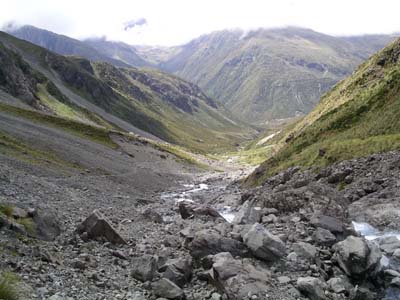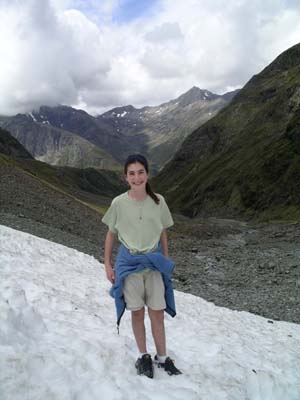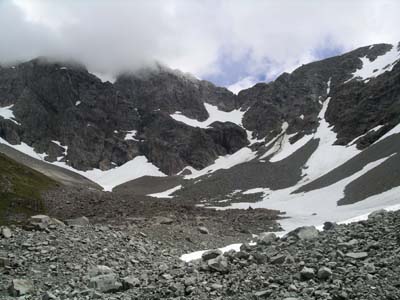Tuesday, January 13 and Wednesday, January 14


Steve and Paula: Our first two days in New Zealand were
spent hiking and getting a sense for the beauty of the Arthur's Pass National
Park. Tuesday's hike took us to the Otira Valley, where we climbed 4 miles
up to the Otira Glacier at the foot of Mount Rolleston. This was a group hike
arranged by the Wilderness Lodge, and we had a wonderful time exploring this
area along with our guide Gerry (who also happens to own the lodge), and a
group of other guests from the lodge. Gerry is typical of most of the New
Zealanders  we've
met - extremely friendly, unbelievably knowledgeable about the area and its
history, and eager to have fun. This helped make today a very fun and educational
day for us all.
we've
met - extremely friendly, unbelievably knowledgeable about the area and its
history, and eager to have fun. This helped make today a very fun and educational
day for us all.
Amazingly, Otira Valley gets 300 inches of rainfall every year, so there
are not many days without rain. Fortunately today was one of those days, and
the weather was perfect. Gerry is an expert on New Zealand plants, and  we
learned about a wide variety of flora including mountain flowers, buttercups,
edelweiss, native carrots and daisies. Some of our more unusual sightings
included a 1,200 year-old New Zealand Cypress, the world's smallest pine tree
(about ½ inch tall), and the world's smallest orchid. Of the country's
we
learned about a wide variety of flora including mountain flowers, buttercups,
edelweiss, native carrots and daisies. Some of our more unusual sightings
included a 1,200 year-old New Zealand Cypress, the world's smallest pine tree
(about ½ inch tall), and the world's smallest orchid. Of the country's
 2,000
flowering plants, about 75% of these are only found in New Zealand. We had
great views during the entire climb, and also enjoyed sharing travel stories
with the other guests on the hike. It turns out that almost everyone we've
met so far are Americans (with some Brits) who have traveled extensively,
often to the same destinations that we're going to.
2,000
flowering plants, about 75% of these are only found in New Zealand. We had
great views during the entire climb, and also enjoyed sharing travel stories
with the other guests on the hike. It turns out that almost everyone we've
met so far are Americans (with some Brits) who have traveled extensively,
often to the same destinations that we're going to.
We reached the Otira Glacier and enjoyed group snowball fights, improvised "sledding" down the snow fields, and climbs through a snow cave (all activities encouraged by Gerry, who took delight in engaging us in a New Zealand vs. America snowball fight). David and Katie greatly enjoyed these activities, and won the admiration from the other guests for their willingness to jump right in with all the "adults"!



 Before
heading back to the lodge, Gerry drove us to see a large wild parrot called
a Kea. Kea's are green birds with bright orange colors under their wings,
and they love to land on cars and beg for food. We found a Kea on a trash
container in a parking lot, and were amazed at how tame these birds are. We
read that these birds are found only on the South Island of NZ, and have been
proven to be the most intelligent animals on earth (smarter than chimpanzees,
dolphins or whales!). The entire population of Keas is estimated to be only
around 3,000.
Before
heading back to the lodge, Gerry drove us to see a large wild parrot called
a Kea. Kea's are green birds with bright orange colors under their wings,
and they love to land on cars and beg for food. We found a Kea on a trash
container in a parking lot, and were amazed at how tame these birds are. We
read that these birds are found only on the South Island of NZ, and have been
proven to be the most intelligent animals on earth (smarter than chimpanzees,
dolphins or whales!). The entire population of Keas is estimated to be only
around 3,000.
We returned to the lodge just in time for a tour and demonstration of the
sheep farm on site. Wilderness Lodge maintains 5,000 merino sheep on its 600
acres. These sheep produce merino wool, one of the finest wools available.
Much of the wool is exported to Italy where it is made into expensive Italian
suits. The demonstration started with Skip, a 9 year-old Border Collie who
is an expert sheep herder. We enjoyed seeing how Skip maneuvered the sheep
from spot to spot at Gerry's command. There are actually two kinds of sheep
dogs. Skip is trained to keep the sheep in a group and move them to specific
locations. Other dogs are "chasers" and are used to push the sheep
through gates. 
The farm operates on an annual cycle where lambs are born each October (springtime), weaned from their mothers in February, and sheared during the summer. Only 150 rams are kept - the rest of the male sheep are sold to other farmers. Gerry explained that the farm has decided to focus on raising the more valuable ewes. Each year, one sheep produces approximately 10 pounds of wool, enough to make 2 suits. We watched Gerry shear a sheep and were amazed with how hard a process this really is. Manual shears are used so that some wool is left on the sheep. By the end of the 10-minute demonstration, Gerry was clearly tired, despite the fact that this particular sheep was highly cooperative. We also enjoyed seeing the lambs, and feeding several orphans that will never be accepted by the other sheep on the farm.


On Wednesday we took a hike through the McKay Moa Forest and up to Wild Boar
Hill where we got fantastic views over the Arthur's Pass area. The climb was
steep, but the views were worth it. Along the way we had fun interacting with
small fantail birds that seemed to follow us as we walked. It turns out that
the birds like to follow hikers so that they can eat the insects that are
disturbed along the way. The mossy forest floor provided a cushioned hiking
surface and the  varieties
of moss along the walk were amazing. We now understand why people say NZ is
paved in carpet!
varieties
of moss along the walk were amazing. We now understand why people say NZ is
paved in carpet! 
The panoramic views of the Southern Alps were striking especially as we descended
back down into the valley. The Southern Alps are actually growing by almost
an inch a year as two tectonic plates under the earth's crust crash into each
other. The Alps rise as a spine along this crash line which extends the entire
length of the South Island. 
Wednesday's hike also included a walk through the Broad Stream Gorge. Broad Stream is extremely dynamic, and its path through the gorge changes frequently. There was a major rainstorm here last week (10 inches of rain during a 24-hour period), and the entire area filled with water. When the stream subsided, brand new tributaries had been formed. Even today, we noticed changes in the paths of the water that had occurred between the time that we left on our hike until the time that we returned.
So far, we have found New Zealand to be as beautiful and interesting as what we had expected (based on what we had heard from others who had been here). What we hadn't expected is the warmth, humor and genuine good nature of the New Zealand people. Everyone here is extremely friendly and welcoming. They are also very focused on conservation and maintaining the natural beauty of the country.
Distance Walked: 8.28 miles on Tuesday, 3.94 miles on Wednesday


Today we decided to add a new dimension to our daily journals. Each of us will try to describe in a few sentences something interesting or moving that we learned each day. We hope this will help us retain some of the wonderful insights we are gaining with each new experience.
 "Paula's
Precious Pearls" ~ I have been amazed at the wonderful interactions and
relationships found in nature and the adaptability of flora. For example,
the wildflowers in New Zealand are almost entirely white or yellow and many
of these flowers open at night rather than in daylight. This is because there
are few butterflies here and plants must depend on moths to pollinate their
species. We also learned that some of the scrubs evolved over time to protect
themselves from the giant Moa birds that once covered the island. These plants
literally turned themselves inside out-their branches growing on the outside
of the scrub and leaves growing inside. When the Moas tried to reach the foliage,
they were poked in their eyes. We saw many of these scrubs on our walks.
"Paula's
Precious Pearls" ~ I have been amazed at the wonderful interactions and
relationships found in nature and the adaptability of flora. For example,
the wildflowers in New Zealand are almost entirely white or yellow and many
of these flowers open at night rather than in daylight. This is because there
are few butterflies here and plants must depend on moths to pollinate their
species. We also learned that some of the scrubs evolved over time to protect
themselves from the giant Moa birds that once covered the island. These plants
literally turned themselves inside out-their branches growing on the outside
of the scrub and leaves growing inside. When the Moas tried to reach the foliage,
they were poked in their eyes. We saw many of these scrubs on our walks.
"David's Daily Dump" ~ Today on our hike a Fantail, native to New
Zealand, followed us on our hike through the mountains. He was attracted by
my whistling, and constantly chirped at us. At first, we supposed he just
liked us and followed us because he enjoyed our company. We later learned
that he was chirping at us to try to get us to move, which would stir all
the insects, so he could eat! This made sense to us as we watched him catch
moths throughout our long hike. 
"Katie's Kwik Kwacks" ~ I learned a lot these past couple of days about the life cycle of sheep, how they are raised, how they are herded, and what they are used for. We learned the basic life cycle of a sheep from start to finish. It was very interesting. We also learned how sheep are raised on the farm. We learned that they have mostly ewes (female sheep), and a few rams (male sheep). In May they allow a ram into an area full of over one hundred ewes, and the ewes give birth in October. We enjoyed feeding and cuddling the little lambs. We also learned and saw a demonstration of sheep dogs herding the sheep into a group and pushing them forward. The sheep dog followed his master's various commands and whistles and moved the sheep in one group by running around them and barking. We learned that there are two kinds of sheep dogs-ones that regroup the sheep by running toward them in different directions, and ones that charge at the sheep forcefully by barking loudly. We also learned what sheep are generally used for. We learned the most about the farm using their fleece to turn into yarn. We watched a sheep being sheared, learned the different qualities of wool, and watched a woman creating yarn by spinning the wool on an old-fashioned spinning wheel. Overall, we have learned a great deal about sheep these last two days and enjoyed participating in daily activities on the farm.
